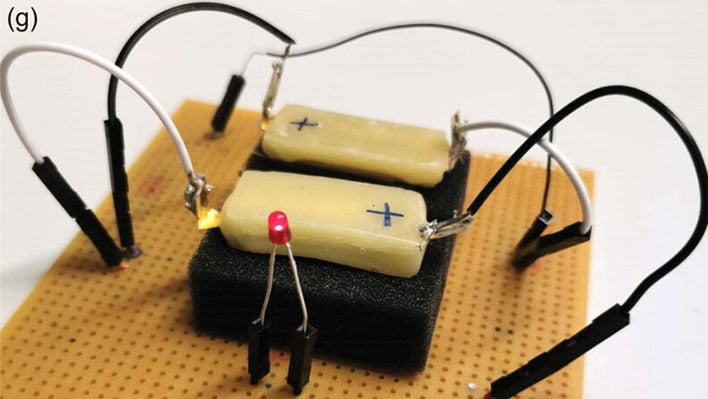Scientists Develop A Tasty Rechargeable Battery Made From Food And Yes It's Edible

Researchers at the Istituto Italiano di Tecnologia (IIT) have created the world’s first fully edible rechargeable battery. Key foodie ingredients of the new battery may include extracts from almonds, pomegranates, mushrooms, capers, seaweed, charcoal, and beeswax. The electrodes also make use of food-grade gold leaf, which may invoke thoughts of extravagant cuisine, but the combination of the flavors outlined isn’t going to win any culinary awards. This low-power rechargeable battery could become a key component in the burgeoning field of edible electronics, with solutions mainly targeting medical devices and the food safety.
The IIT researchers say that their invention was inspired by living organisms which generate electricity. Organisms typically use “redox cofactors to power biochemical machines,” and this is the base technology for this research. In its current state, the edible battery isn’t going to crank out as much voltage as an electric eel though, and it doesn’t even sound powerful enough for tackling the more modest demands of a smartwatch, for example. A proof-of-concept edible rechargeable battery created by the research team operated at 0.65 V, sustaining a current of 48µA for 12 minutes. Don’t worry though, the researchers are already working on cells with both greater capacity and density.
Devices the researchers say the first fully edible rechargeable battery will be suitable for powering include the following ingestible medical devices. These have already been developed, but didn’t have a matching edible power source:
- cameras
- pH monitors
- sensors to detect catechol, uric acid, ascorbic acid, dopamine, and acetaminophen
- radio frequency filters
- microphones
Additionally, other likely near-future candidates for these edible batteries lie in the fields of food safety monitors (using an edible defrost sensor, among others), and in edible soft robotics.

Making An Edible Rechargeable Battery – Ingredients And Method
According to the IIT paper published by Advanced Materials, the battery used an anode made from riboflavin, and a quercetin cathode. Both of those food extracted materials were mixed with food-safe activated carbon to ensure free electrons flow from and to the redox centers, and then encapsulated in beeswax. The battery electrolyte was a 1 mole aqueous solution of sodium hydrogen sulfate using a nori seaweed algae separator. The aforementioned edible gold leaf was used for current connectors.
Replacing Dangerous Battery Tech?
The rechargeable cells in your modern smart devices and other household electronics will often feature dangerous, toxic, and unsustainable materials. Popular commercial rechargeable batteries often count Lithium or Cadmium among their ingredients, and older rechargeable technologies mix a heavy and unpalatable combination of lead and acid.

